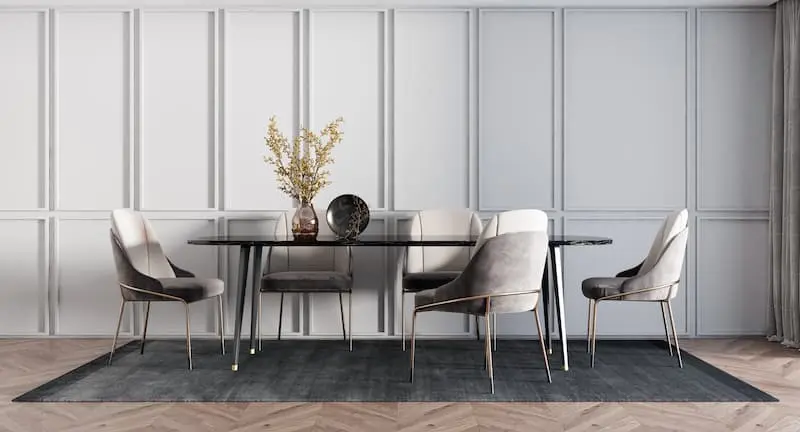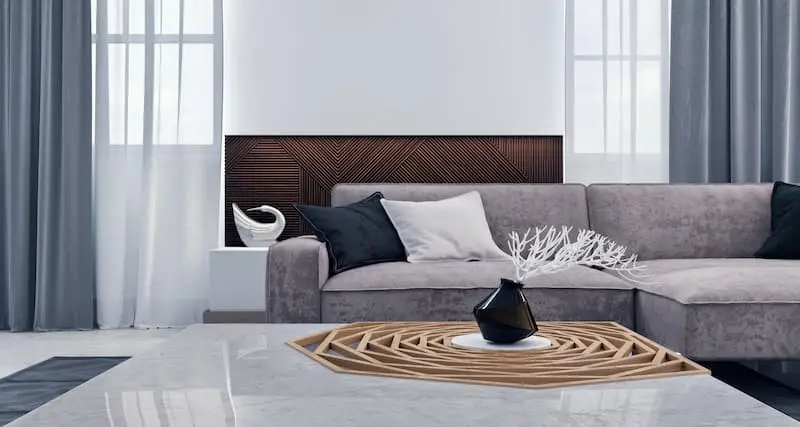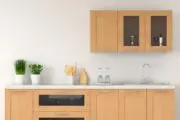Perhaps because of the budget, or the desire to DIY down the road, you may have opted for builder-basic finishes in your new construction home. But that doesn’t necessarily mean you have to have a basic aesthetic. Builder basic offers a great canvas from which to personalize your space. Here are some tips on how to add style to your builder-basic home.
Change the doors, inside and out
Break the mold for your cookie-cutter home exterior and add style to a builder-basic home by changing the front and garage doors.
One of the most impacting parts of an all-important curb appeal is a stylish, welcoming front door and matching garage doors. Opt for a bold, dramatic color, which complements the home’s exterior or choose doors with decorative features which will make your home stand out, such as sidelights or transoms and dramatic hardware.
Inside, upgrade doors to something more stylish than builder grade.
- Pocket or barn doors add to the aesthetic.
- French doors divide the rooms, but still let light stream through, and are a good choice for a home office, living or dining room.
- If you don’t want to swap out the doors entirely, you could paint them a color other than the typical builder white, including the trim (black is bold, and popular).
Replace light fixtures

Builder-grade light fixtures are notoriously bland, but the good news is that changing light fixtures is a reasonable job for a novice DIY homeowner. It’s also a budget-friendly, high-impact way to elevate your aesthetic.
It’s a good idea to do a lighting plan at the construction phase, so that the electrical is in place, and you can switch fixtures and accents over time to refresh your decor, as you wish.
- Always use a layered lighting approach, with a mixture of ambient light, task-oriented and accent lighting to address different uses in a room, as well as playing an appropriate aesthetic role.
- When choosing your fixtures, make sure that the color and style match your overall aesthetic.
- Trending are black matte, brass, gold and chrome light fixtures. Natural, sustainable materials are popular on light fixtures, particularly with chandelier and pendant shades, made from bamboo, rattan and similar materials.
Frame bathroom mirrors to add style to a builder basic home
Getting custom-made mirrors to hang over your bathroom vanity is pricey. Framing in builder-grade mirrors so that they look custom, is not- and is very effective.
The easiest option is a simple wood trim frame, in an accent color to complement your bathroom’s color palettes.
A frame adorned with stone, shells or other natural materials infuses your bathroom with a biophilic vibe.
Install a lit frame, which adds a decorative touch, and elevates functionality for shaving or putting on makeup.
Choose a thick, textured, metallic frame that complements (or intentionally contrasts with) your fixture metals in the bathroom. Pair the mirror frames with striking, metallic sconces for a luxe feel.
Add wood details, like molding and trim
Adding wood details will instantly elevate a builder-grade home from ordinary to luxe. From wainscoting and chair rails in the dining room, to a beadboard or accent wall in the family room or bedroom, there is a lot to choose from.
If you didn’t opt to run your cabinetry to the ceiling in the kitchen with your builder at the construction phase, consider adding molding to make your cabinetry appear taller and more elegant.
Don’t forget the ceiling when adding trim, as celling trim provides some of the most dramatic designs. Tray, waffle weave and coffered ceilings all draw the eye upwards and make the overall aesthetic quality more dynamic.
Add luxe-look window treatments
Bare windows look builder-grade, but adding window treatments instantly elevates the aesthetic, while adding your own personal stamp.
There is a functional aspect as well, as you may be living in a new construction zone, at least temporarily, and/or in a high-density neighborhood, so being able to draw curtains or pull down shades offers much needed privacy, while muffling noise too.
A designer trick is to layer window treatments to create depth, dimension and visual texture. You can either combine sheer drapery with thicker panels or hard window treatments (such as shutters) with panel drapes. Alternatively, you can use similar materials, but layer solids with patterns.
- Roman blinds, plantation shutters, California shutters and simple roller blinds are all trending.
- Opt for high-quality hardware that is the appropriate size for the treatments chosen to complete the luxe look.
- Be mindful of the fact that placement of window treatments is a particularly effective way to draw the eye and change the perception of space. Hanging a curtain rod high and wide in relation to the window will make the room feel more spacious and add more decorative value.
- In a room with tall ceilings, hanging floor-to-ceiling drapery is dramatic, and accentuates the height.
Invest in custom, or custom-look furniture
One way to make your home look a little more custom is to invest in furniture, rather than specific features and finishes of the home itself.
The key is to get elegant but durable, appropriately sized furniture for your spaces. Ideally, take inspiration from the model home from which your home was designed, and pay attention to what furniture pieces are in each room, and how they are arranged.
Model home designers have spent significant time in furnishing the homes to best promote the model home’s features, as well as to heighten the functionality with traffic flow and amplify the sense of space, by putting the right furniture pieces in the right places.
Your design studio consultant can likely tell you where furniture was sourced (it is often custom) or give you advice if your chosen model doesn’t have a physical replica built.
While you may not necessarily be able to purchase the same furniture direct as a consumer (although sometimes you can), it gives you a starting point from which to explore similar pieces through retail.
Refresh with paint
Builder-grade paint tends to be neutral, if not stark white. With so many hues to choose from, and painting techniques that lend drama to your decor, painting is a budget-friendly DIY that will add style to a builder-basic home.
There are varying schools of thought as to how long you must wait in a new construction home to paint the walls, with the general advice to wait between 6-12 months, to give the home time to fully dry and settle. If you do proceed before that, keep in mind that cracks and pops could occur, and need repair.
When choosing paint colors, utilize a room-by-room strategy, and employ the 60-30-10 rule, where 60 percent is the main color, 30 percent a secondary color and 10 percent dedicated to an accent color.
If you aren’t sure about color combinations, consult a color wheel, color app, or even ask color consultants at your local paint store for their best sellers.
Be creative and use color to explore some of the trending decor inspirations, such as the unexpected red theory, and the link between color and mood, health and wellness.
After all, paint color is not a huge commitment, and you can change it easily down the road if your tastes change, or if a certain shade doesn’t land like you thought it would.








